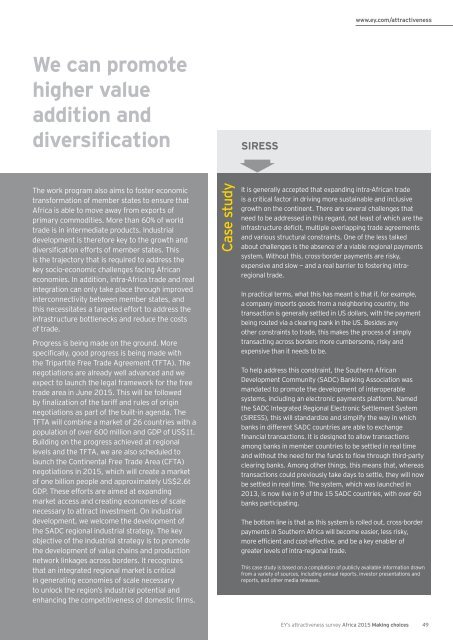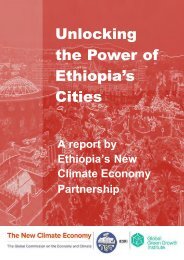EY-africa-attractiveness-survey-june-2015-final
EY-africa-attractiveness-survey-june-2015-final
EY-africa-attractiveness-survey-june-2015-final
Create successful ePaper yourself
Turn your PDF publications into a flip-book with our unique Google optimized e-Paper software.
www.ey.com/<strong>attractiveness</strong>We can promotehigher valueaddition anddiversificationSIRESSThe work program also aims to foster economictransformation of member states to ensure thatAfrica is able to move away from exports ofprimary commodities. More than 60% of worldtrade is in intermediate products. Industrialdevelopment is therefore key to the growth anddiversification efforts of member states. Thisis the trajectory that is required to address thekey socio-economic challenges facing Africaneconomies. In addition, intra-Africa trade and realintegration can only take place through improvedinterconnectivity between member states, andthis necessitates a targeted effort to address theinfrastructure bottlenecks and reduce the costsof trade.Progress is being made on the ground. Morespecifically, good progress is being made withthe Tripartite Free Trade Agreement (TFTA). Thenegotiations are already well advanced and weexpect to launch the legal framework for the freetrade area in June <strong>2015</strong>. This will be followedby <strong>final</strong>ization of the tariff and rules of originnegotiations as part of the built-in agenda. TheTFTA will combine a market of 26 countries with apopulation of over 600 million and GDP of US$1t.Building on the progress achieved at regionallevels and the TFTA, we are also scheduled tolaunch the Continental Free Trade Area (CFTA)negotiations in <strong>2015</strong>, which will create a marketof one billion people and approximately US$2.6tGDP. These efforts are aimed at expandingmarket access and creating economies of scalenecessary to attract investment. On industrialdevelopment, we welcome the development ofthe SADC regional industrial strategy. The keyobjective of the industrial strategy is to promotethe development of value chains and productionnetwork linkages across borders. It recognizesthat an integrated regional market is criticalin generating economies of scale necessaryto unlock the region’s industrial potential andenhancing the competitiveness of domestic firms.Case studyIt is generally accepted that expanding intra-African tradeis a critical factor in driving more sustainable and inclusivegrowth on the continent. There are several challenges thatneed to be addressed in this regard, not least of which are theinfrastructure deficit, multiple overlapping trade agreementsand various structural constraints. One of the less talkedabout challenges is the absence of a viable regional paymentssystem. Without this, cross-border payments are risky,expensive and slow — and a real barrier to fostering intraregionaltrade.In practical terms, what this has meant is that if, for example,a company imports goods from a neighboring country, thetransaction is generally settled in US dollars, with the paymentbeing routed via a clearing bank in the US. Besides anyother constraints to trade, this makes the process of simplytransacting across borders more cumbersome, risky andexpensive than it needs to be.To help address this constraint, the Southern AfricanDevelopment Community (SADC) Banking Association wasmandated to promote the development of interoperablesystems, including an electronic payments platform. Namedthe SADC Integrated Regional Electronic Settlement System(SIRESS), this will standardize and simplify the way in whichbanks in different SADC countries are able to exchangefinancial transactions. It is designed to allow transactionsamong banks in member countries to be settled in real timeand without the need for the funds to flow through third-partyclearing banks. Among other things, this means that, whereastransactions could previously take days to settle, they will nowbe settled in real time. The system, which was launched in2013, is now live in 9 of the 15 SADC countries, with over 60banks participating.The bottom line is that as this system is rolled out, cross-borderpayments in Southern Africa will become easier, less risky,more efficient and cost-effective, and be a key enabler ofgreater levels of intra-regional trade.This case study is based on a compilation of publicly available information drawnfrom a variety of sources, including annual reports, investor presentations andreports, and other media releases.<strong>EY</strong>’s <strong>attractiveness</strong> <strong>survey</strong> Africa <strong>2015</strong> Making choices49



